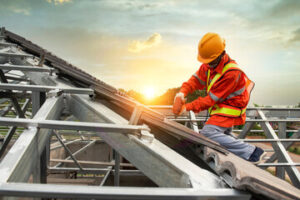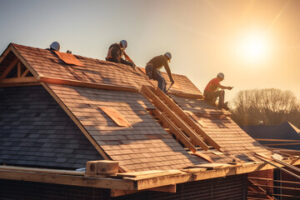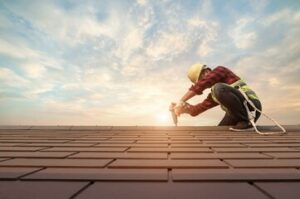The roof is the most important structural component of a house. Its design impacts the overall appearance of a home and can significantly influence its value.

Arthur’s Roofing materials are varied and many options are available. Different types are better suited for different climate conditions and future maintenance needs. The most popular choice is asphalt shingles.
Roofing has evolved from simple thatched roofs to the high-tech, energy-efficient designs of today. The roof is one of the most important components of a building and offers protection from wind, rain, snow, sunlight and heat. It also helps to improve the aesthetic of a structure, making it look more appealing and modern. Roofing has become a testament to mankind’s ability to adapt and innovate, and it continues to evolve with the needs of society and the environment.
In the beginning, humans sought shelter from the elements by retreating into caves. However, they needed a more durable solution when hunting and gathering became a regular activity. This is when the concept of roofing was first developed. Archaeologists have found evidence of early hunters and gatherers constructing small villages with thatched roofs made from animal skins, branches, sticks and mud.
These were created with bitumen that was laced with shards of brick, granite and slate. These shingles were strong, durable and provided excellent insulation, keeping warmth in and the weather out. They were very popular in America, especially in the Midwest where it was often cold and wet.
The shingles were also very easy to install and they could be customized with different colors and patterns. This is what set them apart from other roofing materials that were available at the time.
The roofing industry continued to evolve throughout the 1800s, when people started to treat shingle surfaces with pine pitch and linseed oil for protection from rain, sun and other factors that caused premature deterioration. The shingle industry also began to experiment with various alternatives to cotton rag felts, which were expensive to manufacture.
Materials
Roofs are an essential part of every building, providing protection and insulation against water, heat, sun and other elements. There are many types of roofing materials, each suited for specific purposes and climates. Roofing is a labor-intensive job that requires extensive strength and stamina. It’s not for everyone; falls from ladders, aches and pains, and even more serious injuries can result from the work.
Wooden shingles and shakes are durable roofing options, often made of redwood or cedar. Shingles are wedge-shaped slabs of thin wood formed by precise sawing, while shakes are thicker wedges that are split. These shingles offer superior insulation and water resistance, and can last up to 60 years in dry climates.
Clay tile is a popular choice for homes in southern coastal and desert areas. They are available in a variety of styles, from mission and Spanish-style round-topped tiles to flat French or English designs. Clay tiles are durable, but can add extra weight to the roof and may require more frequent maintenance than other roofing materials. They also become brittle in cold weather, and should be avoided in areas that experience extreme temperatures.
Concrete shingles are another durable roofing option. They can mimic the look of different roofing materials, including asphalt, slate and wood shingles. They are also cost effective, but can be fragile if exposed to harsh conditions like high winds or hail. Concrete shingles are also heavier than other roofing materials, which can put additional stress on the frame of the house and increase utility bills.
Metal roofing is an increasingly popular option due to its durability and longevity. The most common metal roofing is built from a single-ply membrane that’s either glued or mechanically fastened to the roof substrate. The most commonly used single-ply membranes include PVC and TPO (Teflon polymer ethylene), which offer good thermal protection, UV radiation protection, and flexibility.
BUR (built-up roofing) was the most widely used type of roof before membrane roofs became popular, and is still sometimes used for low-sloped roofs and sheds. However, it is labor-intensive, can release toxic fumes during installation, and is not well suited for pitched roofs. Moreover, the installation process can be messy and time-consuming, and finding leaks in this type of roofing is difficult.
Installation
The roof is an important part of any building, protecting it from rain, snow, wind, and sunlight. Roofing is the process of installing, repairing, or replacing the materials that cover a roof. This includes the framework, decking, and outermost layer of material. It also includes flashing and venting systems.
Before starting work, a good roofer will inspect the existing roof to determine if there is any damage and what needs to be done. Then they will provide an estimate and a contract for you to sign. If you are paying through insurance, the insurance company will already have approved the claim and sent a check to get started.
During the actual installation, roofers will use a variety of tools and equipment like hammers, nail guns, ladders, shingle cutters, and hard hats. They will also need to make sure the roofing material they are using meets industry and manufacturer standards, as well as local building codes. After the roofing is installed, they will conduct a final inspection to ensure all work meets their quality standards. They will also clean up the site, removing any nails or other debris that could pose a hazard to residents or pets. They will also verify that the ventilation and insulation have been properly addressed.
Maintenance
The roof is a critical component of any building, providing aesthetic value and all-round protection against the weather. However, a roof can get damaged due to several reasons and hence, it requires maintenance procedures. These procedures can prevent early deterioration of the roofing system which may require costly repairs and even cause interior valuables to be lost.
Roof inspections should be performed regularly to ensure that the integrity of the membrane is maintained. They should also include examining the interior of the structure for leaks and water damage.
Drainage – Examine the gutters, scuppers and downspouts for blockages or inefficient water flow to minimize the possibility of ponding on the roof surface. Also, verify that the slope of these devices is sufficient to discharge rainwater from the roof and not back up into the structure.
Examine the soffit area for signs of water damage such as mold and mildew, drips or water stains and leaks. These can lead to moisture and rot issues within the structure.
Look for holes or dents in the roof that might allow unwelcome creatures to enter the home, especially during summer when heat and sun rays are at their peak. The roof should also be inspected for storm damage, such as torn or missing shingles and flashing, which could cause water leaks.
Check the roof for deterioration such as cracks, blisters, and delamination, which can indicate the need for repair or replacement of the roof membrane. Depending on the type of roofing material, the repair and replacement process may vary.
Other items to check on are:
Inspect stairs, crossovers and platforms for structural soundness, safety hazards (including loose or deteriorated materials), and electrical or hot equipment. Make sure there is adequate signage to warn repair men and other employees of dangerous conditions.
Housekeeping surveys are generally recommended for most roof areas on a monthly basis to keep drainage systems clear and identify potential damaging conditions. Depending on the geographic location and severity of environmental conditions, this survey frequency may need to be increased during certain times of the year.

